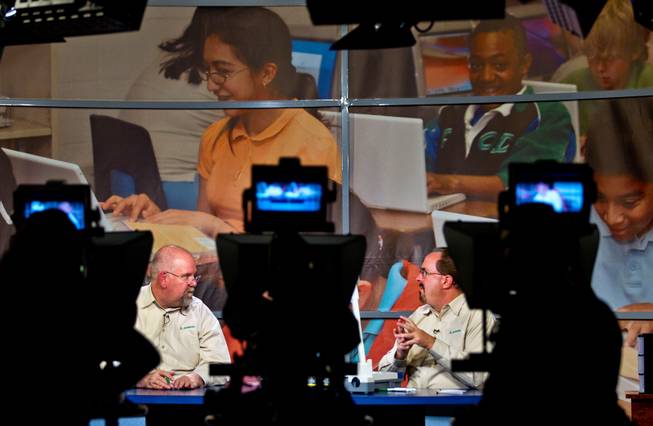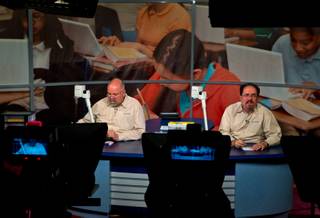
“Homework Hotline” is a Vegas PBS program where two math teachers Andrew Lenselink of Valley High and Andrew Sullivan of Johnson Junior High help kids live on TV with their homework Wednesday, September 24, 2014.
Sunday, Sept. 28, 2014 | 2 a.m.
Andrew Sullivan and Andrew Lenselink are stars of a reality show like no other in Las Vegas.
From 4 p.m. to 5 p.m. Monday through Thursday, the two don matching shirts and become TV tutors on the public television broadcast “Homework Hotline.” Produced through a partnership between the local PBS affiliate and the Clark County School District, the show offers students a chance to call in to receive help on their math homework.
Sullivan, who teaches at Johnson Junior High, and Lenselink, who teaches at Valley High, break down complex problems into simple, easy-to-follow steps using an overhead projector connected to the camera. Rather than just give out answers, the two try to teach students to solve problems themselves.
“What do you think we should do (next)?” is the most common phrase heard on the show.
“We pull it from them by asking the guiding questions,” Sullivan said.
Take the test
Think you’re a smarter than a student? Try your hand at a few questions Clark County School District students must solve. Solve the expression: (a+4) – 8, when a=7.
a: 3
b: 7
c: 19
d: 12
Solve the expression: a^2/(8 – b), when a= 4 and b = -9
a: -.94
b: 16
c: .94
d: -16
Solve for X: 3(x-4) = 18
a: 2
b: 10
c: 30
d: impossible
Extra credit: At the close of every show, the teachers pose a question that isn’t necessarily math-related. The first caller with a correct response receives a $15 gift certificate to Target.
How many pairs of ribs do you have?
a: 16
b: 12
c: 8
d: Half slab
What do we call the island countries in the Caribbean?
a: Bahamas
b: Caribbean Archipelago
c: Virgin Islands
d: West Indies
Answers: a, c, b, b, d
When the teachers hear that “aha” moment from a student, they know their job is done.
Sullivan and Lenselink usually have time to help five or six callers per show. Most of the students are in middle school and ask about pre-algebra equations, although the teachers also field questions about fractions from elementary school students and geometry equations from high schoolers.
Both CCSD and Vegas PBS promote the show on their websites, and the TV station promotes it on air, as well. The teachers limit students to two or three questions per episode.
“We start knowing the students after a while,” Lenselink said. “We have a lot of repeat customers.”
The teachers rarely get stumped.
Sullivan teaches two levels of algebra and seventh-grade math. Lenselink teaches advanced math for high school students. They both double-check each other’s work to ensure solutions are correct.
Some questions are more difficult than others. Sullivan said geometry can be ”maddening” because the children struggle to explain the angles over the phone. Sometimes, their descriptions create an impossible triangle.
If Sullivan and Lenselink can’t solve a question, they call the student back after the show to offer more help.
In the end, both Sullivan and Lenselink hope the students reach a level where they don’t have to call; that means the teachers’ show is a success.
But if students do need to talk, Lenselink and Sullivan will be there after school, ready to answer the next question.


Join the Discussion:
Check this out for a full explanation of our conversion to the LiveFyre commenting system and instructions on how to sign up for an account.
Full comments policy